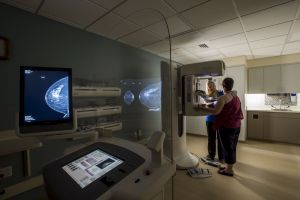October 18, 2017
October 18, 2017
This article was written by Louis Pacilio, MD, lead mammography radiologist at Cooley Dickinson Hospital.
There are two things everyone needs to know about breast health and breast cancer. First, there are many things you can do to maintain breast health. Second, mammography remains the best way to detect breast cancer in its earliest stages.

Maintaining breast health is similar to many other healthy habits. Dental health, for example, requires regular brushing and flossing plus professional cleaning and checkups; bone health requires weight-bearing exercise, sufficient calcium and vitamin D, and not smoking.
Furthermore, it’s recommended to pay attention to factors including family history of cancer, types of cancer and the age at which family members were diagnosed with disease. Families with a strong history of cancer sometimes carry gene mutations that may increase the overall risk.
Other risk factors also play a significant role; The National Cancer Institute has a widely used risk assessment tool that can be completed online.
It’s important to note, however, that while a family history of certain types of cancer can increase the risk of breast cancer, 85 percent of women (and men) who are diagnosed with breast cancer do not have a family history of the disease, nor do they have many of the common risk factors.
Performing regular breast self-examinations can be a key ingredient of effective prevention. Though there are no major research studies showing the efficacy of monthly breast self-exams, we see many patients each year at Cooley Dickinson Hospital who have felt lumps on their own. It’s also helpful to ask your primary care clinician or OB/GYN to perform an annual clinical breast exam. This palpation (feeling the breasts for changes or abnormalities) is a good basic step to maintain breast health.
Our Best Current Tool
The only proven way to identify breast cancer in its early stages is through mammography. When found early, breast cancer is more curable, the long-term prognosis is better, the treatment choices are greater, and the interventions required are less invasive. Talk with your primary care clinician about the screening guidelines for mammography.
There is considerable controversy about when to have a first mammogram. Some national organizations, such as the U.S. Preventive Services Task Force, recommend that mammograms begin at age 50. The American Cancer Society recommends age 45. The American College of Obstetrics and Gynecology recommends offering women the option of mammography from age 40 with all women starting by age 50. The American College of Radiology recommends beginning at age 40.
When to begin annual mammography screening is a personal decision. Before making such a decision, however, it’s important to be well-informed. Talk with your primary care clinician about the overall risks and benefits of mammography and your personal risk, plus the role of breast self-examination and other breast health steps you can take.
I recommend having a first mammogram at age 40. Each year on average, we see 10-15 breast cancers in women below the age of 50 at Cooley Dickinson. I would recommend an even earlier start (age 35) if a close relative (mother or sister) had been diagnosed with breast cancer before the age of 50.
There are two main reasons why many women hesitate to begin or have annual mammograms. One is the chance of a false positive result (more likely to happen with women in their 40s). A false positive result can lead to additional testing – another mammogram, an ultrasound, or a biopsy – that confirms there is no cancer present. The other is exposure to radiation. At Cooley Dickinson’s new Breast Center, we use “low-dose” mammography equipment—machines that deliver less than half of the radiation you’re exposed to during a cross-country airplane flight.
There are other screening options available. Whole-breast ultrasound generates many false positives. Thermography, which relies on a heat-sensitive map of the breast, has not been shown to be effective. MRI is a reliable screening tool but is not used routinely because of its high cost.
Advances in Mammography
Advances in mammography include the recent availability of 3D mammography, also called breast tomosynthesis. Approved by the FDA in 2011, the 3D equipment’s X-ray arm sweeps in a slight arc over the breast, taking several images from several angles and creating sequential layers that recreate a 3D image of the breast. In contrast, 2D mammography relies on a single, flat image.
The top 5 benefits of 3D mammography are:
1) More accurate detection- find up to 20-30% more invasive cancers than 2D mammography
2) Earlier diagnosis- finds smaller invasive cancers giving patients more option for treatment
3) Better detection in dense breast tissue- lets the radiologist see through the breast density to find previously obscured abnormalities
4) Less anxiety from fewer callbacks- decreases mammography callbacks by up to 40%
5) Safe and effective- decreased radiation when using 2D C view and proven mortality improvement
All mammograms at Cooley Dickinson are performed in 3D (unless someone chooses to opt out of 3D). Simultaneous with the 3D scan, 2D images are generated by software from the 3D data, resulting in 1/2 the radiation dose. The 3D

images allow the radiologist to gain a better view and understanding of a woman’s breast tissue. This is especially helpful for women with dense breast tissue.
Whether you choose 3D or more traditional 2D mammography, getting into a routine of an annual mammogram is a key factor in breast health. Early detection of breast cancer is so important – cancers so detected are smaller, more easily treatable, and more curable.
We are excited that the new Breast Center at Cooley Dickinson can offer spacious, comfortable rooms separate from the rest of radiology, where coordinated breast health care with technologists, radiologists, surgeons, and patient health advocates make it a convenient, easy task to look out for your own breast health.
-30-

